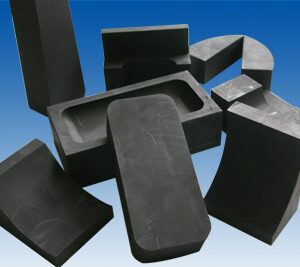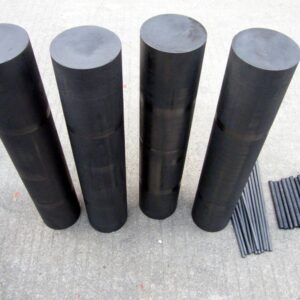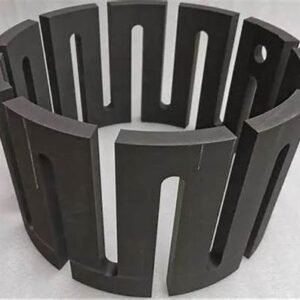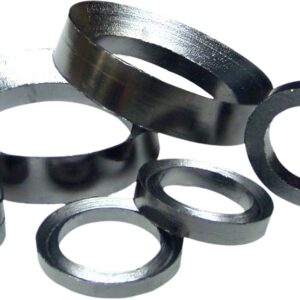1.Core Properties of High-Performance graphite Crucible Materials
In high-temperature industrial sectors, crucibles serve as critical refractory tools whose performance directly impacts smelting efficiency and product quality. Crucibles manufactured primarily from natural flake graphite possess unique physical and chemical attributes, making them an optimal choice for non-ferrous metal smelting. These materials exhibit excellent thermal conductivity, with heat transfer rates 30% higher than conventional refractory materials, enabling rapid and uniform heat distribution to significantly reduce metal melting times.
Thermal stability is another key advantage. With a low coefficient of thermal expansion (1.2–1.5×10⁻⁶/℃), much lower than ordinary ceramic crucibles, they can withstand frequent thermal shocks from sudden heating or cooling without cracking. Experimental data shows that after 50 cycles of rapid temperature changes from 1500℃ to room temperature, the structure remains intact, making them highly suitable for intermittent smelting equipment.
Chemical resistance is equally notable. Against strong acids (e.g., hydrochloric, sulfuric) and alkalis (e.g., sodium hydroxide), the corrosion rate is below 0.05mm/year. They show no chemical reaction with molten metals below 1200℃, making them ideal for refining noble and reactive metals and preventing impurity contamination that could affect metal purity.
2. Technical and Economic Advantages in Diverse Applications
In metallurgy and casting industries, these crucibles are widely used for refining alloy tool steel and melting non-ferrous metals. For copper alloy smelting, their service life is 2–3 times longer than traditional clay crucibles, reducing metal loss by over 15% and energy consumption by 20%, demonstrating strong cost-effectiveness. In mechanical manufacturing, when melting aluminum and its alloys, the smooth inner surface minimizes molten metal resistance, improving casting efficiency—especially critical for precision casting processes requiring high-purity metal liquids.
In chemical industry high-temperature synthesis reactions, their corrosion resistance is pivotal. When producing high-purity titanium alloys, they effectively resist fluoride molten salt erosion, ensuring process stability. In noble metal processing, their non-reactive nature with molten gold and silver makes them ideal for jewelry manufacturing and electronic paste preparation, eliminating risks of metal contamination from traditional crucible materials.
3. Graphite crucible classification System and Application Scenarios
3.1 Types by Heating Methods
- Clay-Based Crucibles for Flame HeatingComposed of natural flake graphite and clay, these suit flame-heated equipment like medium-frequency furnaces and oil-fired furnaces, with a temperature resistance up to 1600℃. Mainly used for bulk smelting of common non-ferrous metals like copper and aluminum, their thick-walled design enhances resistance to flame erosion. A typical application is aluminum alloy melting in automotive wheel hub casting furnaces.
- High-Purity Crucibles for Resistance FurnacesWith a purity exceeding 99.9%, formed by isostatic pressing, these crucibles have a density over 1.85g/cm³. Their ultra-low impurity content makes them perfect for refining noble metals (gold, silver, platinum) and rare earth metals. Used in vacuum resistance furnaces, their low porosity prevents metal liquid gas absorption, ensuring high-purity smelting—common in single-crystal furnaces for semiconductor material production.
- Ceramic-Bonded Crucibles for Laboratory UseCombining graphite’s thermal conductivity with ceramic’s oxidation resistance, these crucibles operate between 1200–2000℃. Designed for small-scale laboratory smelting, such as synthesizing platinum-group metal compounds or developing new alloy formulas in academic research, their compact size allows precise process control.
3.2 Classification by Temperature Range
- Low-Temperature (≤1200℃): Suitable for melting low-melting-point metals like zinc and lead, commonly used in lead alloy melting for battery plate production.
- Medium-Temperature (1200–1650℃): Covers the melting range of copper, aluminum, and their alloys, making them the mainstream choice in die-casting industries.
- High-Temperature (1650–2000℃): Engineered for refractory metals like titanium and zirconium, essential in manufacturing aerospace-grade high-temperature alloys.
4. Material Composition and Maintenance Guidelines
The primary components are natural flake graphite (70–80%) and binders like clay and resin. The oriented arrangement of graphite flakes provides anisotropic thermal conductivity, while the ceramic phase formed by sintering binders enhances structural strength. This composite structure balances high thermal conductivity with resistance to mechanical impacts.
Notably, despite excellent high-temperature resistance, these crucibles are prone to oxidation in strongly oxidizing atmospheres. Above 800℃, oxygen reacts with graphite to form CO, gradually thinning the crucible wall. To mitigate this, operational measures are essential: maintain weakly reducing atmospheres in flame-heated equipment, use inert gas protection in resistance furnaces, and ensure airtight seals in vacuum furnaces. These practices can extend service life by over 40%, significantly reducing consumable costs in industrial production.
In summary, these graphite-based crucibles offer irreplaceable value in high-temperature smelting through multi-dimensional performance advantages and a refined classification system. With advancements in material preparation technology, their application potential in emerging fields like new energy materials (e.g., lithium battery cathode material sintering) continues to expand, promising a broad development






Reviews
There are no reviews yet.